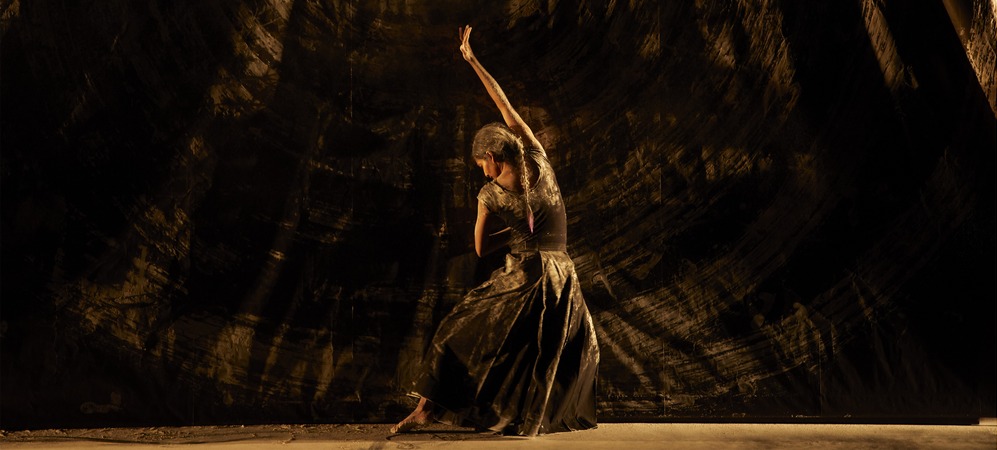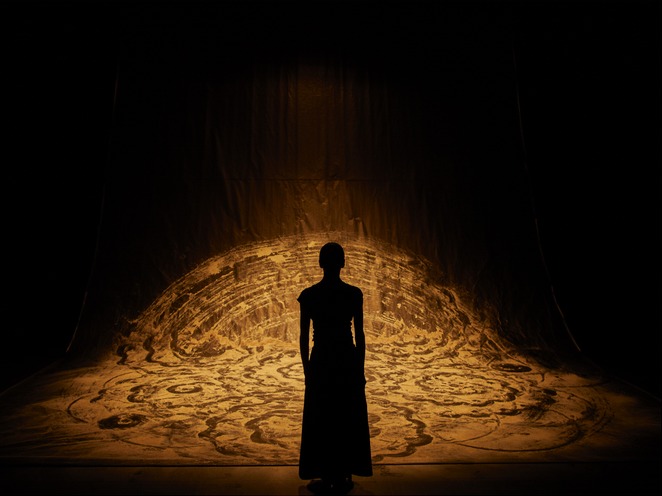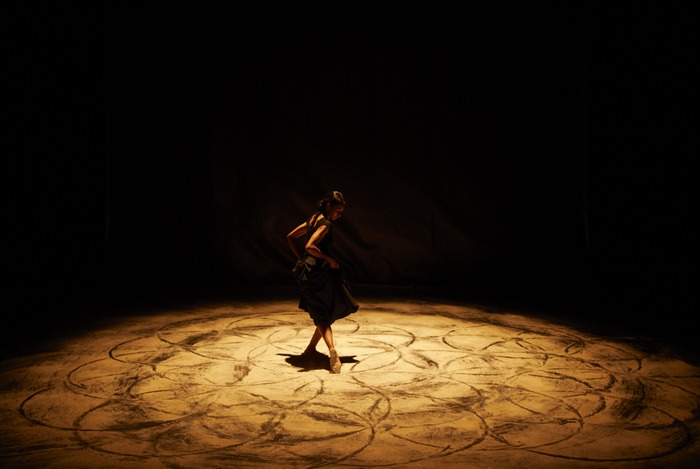[:en]
A PIECE BY AURÉLIEN BORY FOR SHANTALA SHIVALINGAPPA

aSH | (c) Aglaé Bory
CAST
Design, scenography, direction • Aurélien Bory | with Shantala Shivalingappa and Loïc Schild (percussions)
Dramaturgy • Taïcyr Fadel | Light design • Arno Veyrat | Music • Joan Cambon | Set Technical Conception • Pierre Dequivre, Stéphane Chipeaux-Dardé | Costumes • Manuela Agnesini with the valuable help of Nathalie Trouvé | Technical director • Arno Veyrat | Stage manager • Thomas Dupeyron
Sound manager • Stéphane Ley | Light manager • Mallory Duhamel | Head of productions • Florence Meurisse | Production manager • Clément Séguier-Faucher | Logistic manager • Justine Cailliau Konkoj | Press • Plan Bey Agency
PRODUCTION Compagnie 111 – Aurélien Bory
COPRODUCTION (in progress) ThéâtredelaCité – CDN Toulouse Occitanie, Festival Montpellier Danse 2018, Agora – PNAC Boulazac-Nouvelle-Aquitaine, La Scala – Paris, L’Onde Théâtre Centre d’Art, Vélizy-Villacoublay. With the participation of ENSATT-Lyon.
REHEARSALS AND RESIDENCIES La nouvelle Digue-Toulouse, ThéâtredelaCité – CDN Toulouse Occitanie
Compagnie 111 – Aurélien Bory is under funding agreement with the Regional Directorate for Cultural Affairs Occitanie / French Ministry of Culture and Communication, Region Occitanie / Pyrénées – Méditerranée and the City council of Toulouse. It is supported by the Departmental Council of Haute-Garonne.

aSH | (c) Aglaé bory
In Shantala Shivalingappa’s name we find Shiva, the lord of dance. According to the texts, Shiva has over one thousand names. He is the god of creation and destruction. Lord of cremation grounds, his body is covered with ash. Shantala Shivalingappa’s dance revolves around the figure of this god, whose vibration gives rise to the rhythm of the world.
I asked Shantala if she wanted to experience ash. Ash is not merely the solid residue of perfect combustion : it is a process. Ash is a fertiliser. It is part of a cycle of death and birth. Ash therefore possesses the potentiality of life. Is this why it is sacred in India, why cremation grounds have a particular energy, why life and death are but one and the same in the cycle of reincarnations? What does Shiva do? He destroys and he dances.

aSH | (c) Aglaé Bory
I met Shantala Shivalingappa in 2008, in the corridors of the theatre, in Dusseldorf with Pina Bausch. It was the last “Drei wochen mit Pina” festival. Shantala danced with Pina Bausch in Nefés, she also presented a solo, as well as a duet with Sidi Larbi Cherkaoui. It was there that Shantala saw Plus ou moins l’infini (More Or Less, Infinity). It was a time of strong convergence that seems almost unreal to me, considering that it brought together a number of elements which were going to be significant to my path and to that of Shantala’s. Something was going to die here and something else was going to be reborn.
Shantala’s dance is moulded by this journey between Kuchipudi and Pina Bausch, between India and Europe, between Shiva and Dionysus, who are said to be incarnations of the same deity, Shiva having lived on in Hindu mythology while Dionysus, swept aside by monotheistic religions, was gradually forgotten in Europe, a wandering god, god of theatre. Shantala constantly travels back and forth between Madras where she was born, and Paris where she lives. Her dance mirrors this perpetual swinging, somewhere between Hindu mysticism and quantum physics.
I pictured Shantala Shivalingappa dancing on ash for aSH, the title of which is made up of the initials and last letters of her name. aSH is the final opus in the trilogy of portraits of women, ten years after it began in 2008 with Questcequetudeviens? (What’s Become of You ?), followed by Plexus in 2012. In this trilogy, my starting point is not space, which is my usual subject matter in theater, but a woman, a person who has her own story. This trilogy is about a living being unfolding through dance. With aSH, Shantala Shivalingappa dances beyond herself. In a set designed from ash and vibrations, she incarnates Shiva who propels the world into manifesting and allows space to dance.
Aurélien Bory • September 2017
[:fr]
UNE PIÈCE D’AURÉLIEN BORY POUR SHANTALA SHIVALINGAPPA

DISTRIBUTION
Conception, scénographie et mise en scène Aurélien Bory | Avec Shantala Shivalingappa et Loïc Schild (percussions)
Collaboration artistique Taïcyr Fadel | Création lumière Arno Veyrat | Composition musicale Joan Cambon | Conception technique décor Pierre Dequivre, Stéphane Chipeaux-Dardé
Costumes Manuela Agnesini avec l’aide précieuse de Nathalie Trouvé | Régie générale Arno Veyrat
Régie plateau Thomas Dupeyron | Régie son Stéphane Ley | Assistant à la création lumière et régie Mallory Duhamel | Directrice de production Florence Meurisse | Administrateur Clément Séguier-Faucher | Chargée de production Justine Cailliau Konkoj | Presse Agence Plan Bey
PRODUCTION Compagnie 111 – Aurélien Bory
COPRODUCTION ThéâtredelaCité – CDN Toulouse Occitanie, Festival Montpellier Danse 2018, Agora – PNAC Boulazac-Nouvelle-Aquitaine, La Scala – Paris, L’Onde Théâtre Centre d’Art de Vélizy-Villacoublay. Avec la participation artistique de l’ENSATT-Lyon.
ACCUEIL EN RÉPÉTITIONS ET RÉSIDENCES La nouvelle Digue – Toulouse, ThéâtredelaCité – CDN Toulouse Occitanie
La Compagnie 111 – Aurélien Bory est conventionnée par la Direction Régionale des Affaires Culturelles d’Occitanie – Ministère de la culture et de la communication, la Région Occitanie / Pyrénées – Méditerranée et la Mairie de Toulouse. Elle reçoit le soutien du Conseil Départemental de la Haute-Garonne.

aSH | (c) Aglaé Bory
Dans Shantala Shivalingappa, il y a Shiva, dieu de la danse. Shiva possède d’après les textes plus de mille noms. Il est un dieu créateur et destructeur. Seigneur des lieux de crémations, il se recouvre le corps de cendres. Shantala Shivalingappa a construit sa danse sur la figure de ce dieu, dont la vibration, rythme la manifestation du monde.
J’ai demandé à Shantala si elle voulait faire l’expérience de la cendre. La cendre n’est pas uniquement les résidus solides d’une combustion parfaite, elle est un processus. La cendre est un fertilisant. Elle s’inscrit dans un cycle de mort et de naissance. La cendre possède ainsi une potentialité de vie. Est-ce pour cela qu’elle est sacrée en Inde, que les champs de crémations possèdent une énergie particulière, que vie et mort sont une seule chose dans le cycle des réincarnations ? Que fait Shiva ? Il détruit et il danse.
J’ai rencontré Shantala Shivalingappa en 2008, dans les couloirs du théâtre, à Düsseldorf chez Pina Bausch. C’était le dernier festival « Drei wochen mit Pina ». Shantala dansait avec Pina Bausch dans Nefes, elle présentait également un solo et aussi un duo avec Sidi Larbi Cherkaoui. C’est là que Shantala a vu Plus ou moins l’infini. Il s’est passé dans ce lieu une forte convergence, qui me paraît presque irréelle tant elle a réuni d’éléments qui allaient être significatifs dans mon parcours et dans celui de Shantala. Quelque chose allait mourir ici et quelque chose d’autre allait renaître.

aSH 2018 | (c) Aglaé Bory
La danse de Shantala est faite de ce parcours entre le Kuchipudi et Pina Bausch, entre l’Inde et l’Europe, entre Shiva et Dionysos dont d’aucuns disent qu’ils sont issus d’un seul et même dieu, Shiva ayant été perpétué dans la mythologie hindoue alors que Dionysos, balayé par les cultes monothéistes était délaissé peu à peu en Europe, dieu errant, dieu du théâtre. Shantala n’a de cesse de réaliser des allers-retours entre Madras où elle est née et Paris où elle vit. Sa danse effectue un balancier perpétuel, quelque part entre mystique hindoue et physique quantique.
J’ai imaginé que Shantala Shivalingappa allait danser sur de la cendre pour aSH, dont le titre est composé des initiales et des finales de son nom. aSH est le dernier opus de la trilogie des portraits de femme, dix ans après l’avoir initiée, cette même année 2008 avec Questcequetudeviens? et poursuivie en 2012 avec Plexus. Dans cette trilogie où je prends comme point de départ, non pas l’espace qui est ma question au théâtre, mais une femme, une personne qui a son histoire. Il s’agit d’un être vivant qui se déploie par la danse. Avec aSH, Shantala Shivalingappa danse au-delà d’elle-même. Dans un dispositif de cendres et de vibrations, elle incarne Shiva qui permet au monde de se manifester et à l’espace de danser.
Aurélien Bory • Sept. 2017